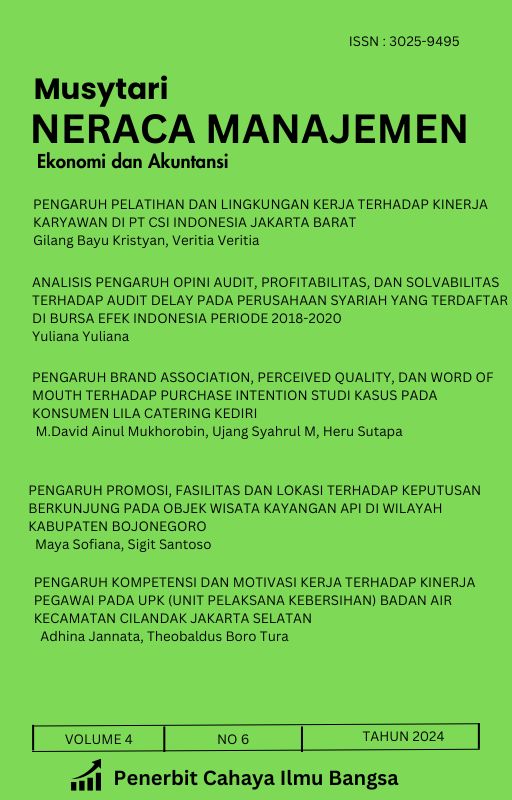STRATEGI KOMPETITIF, INOVASI, DAN ORIENTASI PASAR: KAJIAN LITERATUR UNTUK MENINGKATKAN DAYA SAING BISNIS
Main Article Content
Abstract
Penelitian ini membahas hubungan antara strategi kompetitif, inovasi, dan orientasi pasar sebagai faktor utama dalam mendukung keberhasilan serta daya saing bisnis. Dengan menggunakan pendekatan kajian literatur sistematis, artikel ini mengeksplorasi bagaimana masing-masing elemen tersebut berkontribusi terhadap penciptaan nilai dan keunggulan bersaing yang berkelanjutan. Strategi kompetitif membantu perusahaan memosisikan diri di pasar melalui efisiensi biaya, diferensiasi, atau fokus pada segmen tertentu. Sementara itu, inovasi memungkinkan perusahaan untuk menciptakan produk, proses, dan model bisnis yang relevan dan disruptif. Di sisi lain, orientasi pasar menjadi dasar bagi perusahaan untuk memahami kebutuhan pelanggan dan dinamika pasar, yang mendukung efektivitas strategi dan inovasi. Hasil kajian menunjukkan bahwa integrasi antara ketiga elemen tersebut sangat penting dalam menghadapi tantangan kompetitif di era modern. Artikel ini juga menawarkan implikasi praktis bagi perusahaan untuk mengoptimalkan pendekatan strategisnya guna menciptakan keunggulan bersaing yang berkelanjutan.
In this research, the nature of the competitive strategy, innovation, and market orientation are analyzed as the foremost factors contributing towards an adequate business success and competitiveness. This article pursues the systematic literature review method by which lays down the manner in which each of the factors contributes to the creation of value and sustainable competitive advantage. According to competitive strategy, however, firms position themselves in the market either by cost efficiency, difference, or focus on the specific segments. Then, by innovation, a company is capable of creating better, more appropriate, and often radically different products, services, technologies, processes, and business models. On the contrary, market orientation forms the basis on which a company understands customer needs and dynamics, thus fostering better strategies and innovation. The review reveals that the integration of these three components is essential for that competitive challenge of the present time. Finally, the article outlines the implications of this for practice, within which organizations can optimize their strategic moves for the achievement of sustainable competitive advantages.
Downloads
Article Details

This work is licensed under a Creative Commons Attribution-NonCommercial 4.0 International License.
This work is licensed under a Creative Commons Attribution-ShareAlike 4.0 International License.
References
Abdul-Halim, H., Ahmad, N. H., Geare, A., & Thurasamy, R. (2019). Innovation culture in SMEs: The importance of organizational culture, organizational learning and market orientation. Entrepreneurship Research Journal, 9(3).
Cai, W. (2023). Analysis of Procter & Gamble company’s business strategy based on the Harvard Analytical Framework. Highlights in Business, Economics and Management, 23, 94–100.
Chaudhuri, R., Chatterjee, S., Mariani, M. M., & Wamba, S. F. (2024). Assessing the influence of emerging technologies on organizational data driven culture and innovation capabilities: A sustainability performance perspective. Technological Forecasting and Social Change, 200, 123165.
Distanont, A. (2020). The role of innovation in creating a competitive advantage. Kasetsart Journal of Social Sciences, 41(1), 15–21.
Farida, I., & Setiawan, D. (2022). Business strategies and competitive advantage: The role of performance and innovation. Journal of Open Innovation: Technology, Market, and Complexity, 8(3), 163.
Glimstedt, H. (2020). The iPhone and its antecedents: Re-thinking entry and the evolution of platform strategies at Apple Inc. Entreprises et Histoire, 1, 120–151.
Hamzah, M. I., Othman, A. K., & Hassan, F. (2020). Mediating effects of individual market orientation on the link between learning orientation and job performance. Journal of Business & Industrial Marketing, 35(4), 655–668.
Hunt, S. D., & Madhavaram, S. (2020). Adaptive marketing capabilities, dynamic capabilities, and renewal competences: The “outside vs. Inside” and “static vs. Dynamic” controversies in strategy. Industrial Marketing Management, 89, 129–139.
Lee, C.-H., Hoehn-Weiss, M. N., & Karim, S. (2021). Competing both ways: How combining Porter’s low‐cost and focus strategies hurts firm performance. Strategic Management Journal, 42(12), 2218–2244.
Lee, J.-Y., & Day, G. S. (2019). Designing customer-centric organization structures: Toward the fluid marketing organization. In Handbook on customer centricity (pp. 108–132). Edward Elgar Publishing.
Markard, J. (2020). The life cycle of technological innovation systems. Technological Forecasting and Social Change, 153, 119407.
Na, Y. K., Kang, S., & Jeong, H. Y. (2019). The effect of market orientation on performance of sharing economy business: Focusing on marketing innovation and sustainable competitive advantage. Sustainability, 11(3), 729.
Paley, N. (2021). The manager’s guide to competitive marketing strategies. Routledge.
Roy, S. N., & Roy, S. (2024). Economies of scale in retail sectors-Lowering cost and assuring competitive price. Educational Administration: Theory and Practice, 30(4), 854–864.
Saputra, A. R., Haryono, T., & Untoro, W. (2019). Green products strategy impact of generic Porter strategy on company’s performance. International Review of Management and Marketing, 9(1), 52.
Sari, I. P., & Atmaja, F. T. (2024). Impact of social comparison and peer pressure on iphone consumer happiness and innovativeness. Manajemen Dan Bisnis, 23(1), 42–55.
Si, S., & Chen, H. (2020). A literature review of disruptive innovation: What it is, how it works and where it goes. Journal of Engineering and Technology Management, 56, 101568.
Snihur, Y., & Wiklund, J. (2019). Searching for innovation: Product, process, and business model innovations and search behavior in established firms. Long Range Planning, 52(3), 305–325.
Snyder, H. (2019). Literature review as a research methodology: An overview and guidelines. Journal of Business Research, 104, 333–339.
Sudirjo, F. (2023). Marketing strategy in improving product competitiveness in the global market. Journal of Contemporary Administration and Management, 1(2), 63–69.
Udriyah, Tham, J., & Azam, S. J. (2019). The effects of market orientation and innovation on competitive advantage and business performance of textile SMEs. Management Science Letters, 9(9), 1419–1428.
Vence, X., & Pereira, A. (2019). Eco-innovation and Circular Business Models as drivers for a circular economy. Contaduría y Administración, 64(1).

